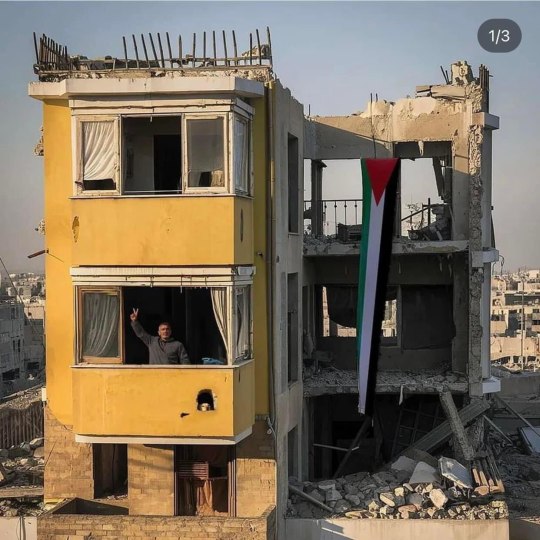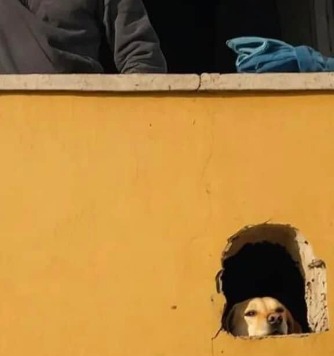#which demonstrate immense virtue on the part of both beings photographed and the photographer
Explore tagged Tumblr posts
Text
[id: three images of a palestinian person raising a hand with his fingers in a "v" shape out the balcony of a bombed yellow apartment building. in the first image, the right half of the building where exterior walls have been destroyed is show, with a long palestinian flag hanging from the damaged top floor cieling.
in the second, the shot is zoomed into the balcony where the person stands. he has brown skin, short grey and black hair, and short grey facial hair. in the bottom corner of the balcony a blonde dog sticks their face out of a hole in the balcony wall. the third image zooms in closer on the dog resting their chin on the bottom of the hole. end id]
[plaintext description: a palestinian citizen and his dog from Gaza raises the victory sign from inside his destroyed home.]



A PALESTINIAN CITIZEN AND HIS DOG FROM GAZA RAISES THE VICTORY SIGN FROM INSIDE HIS DESTROYED HOME.
#some ppl in the notes being really fucking weird abt the dog#i dont like how the shows of empathy on this post focus disproportionately on the dog and talk abt turning them into a meme#if ur not palestinian maybe dont talk about making memes out of images where palestinian people demonstrating incredible resilience pride#and courage are cropped out cause their dog is cute#some of you really need to shut the fuck up and treat palestinians like human beings and genocide like genocide.#anyway. if you relate more to the dog than the human being who sustained them through ongoing bombardment and starvation then#you have some serious work to do as a person and as a member of a global community#un fucking believable#i dont want to derail this post by calling out that ignorant tasteless bullshit so im gonna focus on making sure the full series of images#which demonstrate immense virtue on the part of both beings photographed and the photographer#are more accessible to people who may otherwise not have access to them
59K notes
·
View notes
Text
Why This Photographer Set Out to Break Muslim Stereotypes
At the point when Lynsey Addario moved to India in 2000 and started covering Muslim people group all through Asia, she was acquainted with nuanced perspectives of Islam and the general population who rehearse it. In the wake of returning home to visit the U.S., she saw the religion depicted in a non specific, one-dimensional way that didn't catch what she saw somewhere else on the planet.
That divergence pushed her to work with Muslim people group crosswise over America with an end goal to recount their stories broaderly. Addario's pictures show up in the component story "How Muslims, Often Misunderstood, Are Thriving in America," distributed in the May 2018 issue of National Geographic magazine. She conversed with us about her experience recording these groups and how it has urged her to analyze her own confidence.
Read Prophet Muhammad’s Quotes
JEHAN JILLANI: You have been capturing the Muslim world for more than eighteen years now. What influenced you to need to turn the focal point without anyone else nation? Also, how was it covering this point?
LYNSEY ADDARIO: I experienced childhood in the United States, however have been living abroad since 2000, when I moved to India, and began covering life under the Taliban in Afghanistan. That was the first of numerous treks everywhere throughout the Muslim world– I at that point moved from South Asia to the Middle East to Africa. Every single one of these treks acquainted me with a more nuanced perspective of Islam—from the different translations of the religion to the assorted variety of the general population who rehearsed Islam. Also, each time I would return home to the U.S to invest energy with my family, I would watch the news and tune in to encompassing discussions, and would definitely observe an extremely one-dimensional perspective of the religion, and Muslims as a rule. It was astonishing to me, in light of the fact that there were these broad speculations being made about Muslims, as though everybody was the same, and it appeared to be greatly uninformed. It is the reason I chose to pitch this story quite a long while prior to demonstrate the broadness and assorted variety inside the religion.
JILLANI: Islam in America, as Leila Fadel's piece clarifies in more noteworthy detail, is a standout amongst the most differing religions in the United States. How could you choose which groups to photo?
ADDARIO: Well, as a matter of first importance, there are so a huge number of pictures that I shot, and individuals I concentrated on who never made it into the story, for the most part by virtue of space. I endeavored to photo the range, from the religiously traditionalist to the more liberal, from astounding scenes—like a group of five sisters, three of which were dark belts in taekwondo—to the more common scenes we see—like supplication, to ladies with and without hijab—to appear, essentially, that these generalizations [that are] regularly propagated simply don't frequently hold.
As in any populace of individuals who fall under any religious gathering, from Christianity to Judaism to Islam, there is assorted variety inside. There are those that are more faithful, and the individuals who all the more freely see; there are unimaginably proficient, respectable individuals, and afterward there are crooks. It is imperative to perceive this. In America, I frequently observe Muslims in an indistinguishable sentence from the word fear based oppressors, and this is simply excessively shallow for a various nation like America. Indeed, there are Muslim psychological oppressors, however there are additionally American fear based oppressors who have been in charge of numerous mass shootings over the US. In any case, shockingly, they aren't frequently alluded to as psychological militants.
JILLANI: On a related note, might you be able to address what you seen about the racial assorted variety of Muslim Americans?
ADDARIO: I think there is a vast misguided judgment that Muslims are frequently Arab or South Asian, however 13 percent of the Muslim people group is African-American, starting back to the season of servitude in the U.S. what's more, to the individuals who brought their religion over from Africa. There was likewise incredible expansion among the African-American people group at the season of Malcolm X and the social equality development, and today, there are an immense number of believers to Islam– just about 23% of the whole Muslim American population– from each ethnicity and a scope of groups the nation over. I needed to incorporate this racial assorted variety in the piece.
JILLANI: This is a quite individual inquiry, however given the idea of this story, I am interested to hear: What is your relationship to confidence?
ADDARIO: I was raised Italian Catholic, with the custom of going to chapel each Sunday, before a major family lunch at one of my grandmas', and religion classes on Tuesday evenings. Yet, as I developed into a young lady, I recognized less with Catholicism, and figured out how to acknowledge diverse parts of various religions. I am a profound individual, and I have awesome regard for every single distinctive religion, yet I for one never again go to chapel each Sunday. It's intriguing, in light of the fact that I have been capturing in moderately perilous spots for quite a while now, and have invested a lot of energy with individuals from various religions. I regularly get messages or messages or calls from companions the world over, saying that they are petitioning God for me—regardless of whether Christian or Catholic or Muslim. My grandma, who is 104, dependably goes to Saint Ann for me, and my dear companion Lubna, who lives in Saudi, will actually go to Mecca to appeal to God for me when I have gone to Syria previously. I adore and regard that about confidence, that everybody has his or her convictions which bring them through troublesome circumstances.
JILLANI: In reporting, one will definitely need to cover groups that one isn't a piece of. In any case, I question that it is dependably a simple or agreeable experience. How would you explore that line between being both aware and curious?
ADDARIO: I have dependably trusted that it is vital to be curious, to make inquiries, to instruct oneself about the obscure. I suspect as much contempt and misconception originates from obliviousness and pomposity, and that is a disgrace. Indeed, I felt unusual as a non-Muslim, shooting this thorough piece on Islam—however I don't fake to comprehend what I don't have the foggiest idea. I simply shoot what I see, and what I accept is a reasonable portrayal of a story.
Read Prophet Muhammad’s 100 Quotes
0 notes